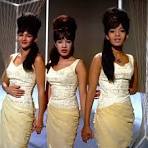Summary
By 1961, the trio signed with Colpix Records under the name Ronnie and the Relatives and released singles that failed to chart nationally. Their fortunes changed in 1963 when they connected with producer Phil Spector, who signed them to Philles Records and rebranded them as The Ronettes.
Breakthrough and the “Wall of Sound”
https://www.youtube.com/watch?v=jSPpbOGnFgk
Phil Spector’s revolutionary “Wall of Sound” production style transformed The Ronettes into icons of the girl-group era. Their first major hit, “Be My Baby” (1963), soared to No. 2 on the Billboard Hot 100, becoming one of the most influential pop records of all time. The song’s lush orchestration, pounding drums, and Ronnie’s emotive lead vocals epitomized Spector’s sonic vision.
Other hits followed, including:
- “Baby, I Love You”
- “(The Best Part of) Breakin’ Up”
- “Walking in the Rain” (which won a Grammy for Best Sound Effects)
In 1964, they released their only studio album, Presenting the Fabulous Ronettes Featuring Veronica, now ranked among Rolling Stone’s 500 Greatest Albums of All Time.
Image and Cultural Impact
The Ronettes broke the mold of the polished, demure girl-group archetype. With their towering beehive hairstyles, dramatic eyeliner, and tight skirts, they projected a “bad-girl” glamour that resonated with urban youth. Their look influenced fashion trends and became synonymous with 1960s pop culture.
They also made History as the only girl group to tour with The Beatles during their 1966 U.S. tour and as the first to open for the Rolling Stones in the UK. These high-profile appearances cemented their status as international stars.
Challenges and Breakup
Despite their success, tensions grew behind the scenes. Ronnie’s marriage to Phil Spector in 1968 and Spector’s controlling behavior contributed to the group’s decline. By 1967, the Ronettes had disbanded, though Ronnie later revived the name briefly in the 1970s before pursuing a solo career. Her memoir, Be My Baby: How I Survived Mascara, Miniskirts, and Madness, chronicles these turbulent years.
Legacy
The Ronettes’ influence on music is immeasurable. Their sound and style inspired generations of artists, from The Beach Boys and Billy Joel to Amy Winehouse. “Be My Baby” remains a cornerstone of pop History, inducted into the Grammy Hall of Fame in 1999. The group was inducted into the Rock and Roll Hall of Fame in 2007, affirming their place among the greats. ,
Why They Matter
The Ronettes didn’t just sing songs—they embodied a cultural shift. They fused streetwise attitude with sophisticated production, creating a blueprint for modern pop stardom. Their music still echoes in contemporary hits, proving that the girl-group era was more than a trend—it was a revolution.
